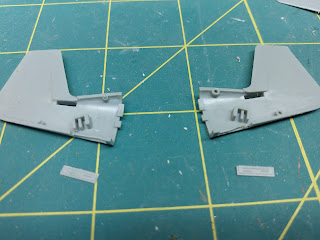Reality is a concept firmly rooted in the imagination. This blog is a pretty much imaginary place for me to showcase my attempts to represent in reality some of the things that have come to live in my imagination.
Thursday, July 25, 2024
Airbrushing shoes
Thursday, June 27, 2024
Sleestak Bust
Saturday, May 18, 2024
Rest in Peace, Brig Gen Clarence E. "Bud" Anderson USAF (Ret)
I was saddened to find out from Max's Models YouTube channel, which I heartily recommend, that Bud Anderson passed away yesterday. He had one heck of a good run, though, with 102 years of a life well-lived.
Thursday, February 29, 2024
Academy 1/72 P-51B, Bud Anderson's Old Crow


I'll have to take some more pictures of the finished model and post them later.

Italeri No. 6037, 1/72 scale Austrian & Russian General Staff
I decided that repainting three generals wasn't too much trouble, but that repainting 18 grenadiers was out of the question. Before this, my figure painting experience was modern figures, generally WWII troops in monochrome uniforms. I could practically paint an entire platoon in olive drab in the time it takes to paint one Pavlovski grenadier! (Yes, while painting these, I kept telling myself to just be patient. The more patient I was, the better I enjoyed painting them. But that didn't mean I wanted to start over!)
One modification I made, based on the review of this set at Plastic Soldier Review, was to shave the monogram of Czar Alexander from the saddle blankets and paint on a star of St. Andrew. All the painting was with various Vallejo colors, except for some shiny bits that I painted with my old stock of Model Master metallics. The turf on the bases is Woodland Scenics held down with some of their scenery cement, which I then thinned and let soak into the attached turf to help it hold together.
Saturday, January 13, 2024
Carpenters' Hall
Carpenters' Hall at 320 Chestnut Street in Philadelphia is an important historic site, and among other claims to fame was the meeting place of the First Continental Congress in 1774. The first thing a modern-day visitor probably notices upon entering is a display case near the center of the hall, housing a 1/24 scale diorama showing the building under construction in 1770. The diorama was made at the Hagley Museum about 40 years ago, and as closely as possible its construction matches that of the real thing, with wooden framing held together with dowels and wooden shingles being laid on the rafters, cedar shingles, and copper flashing. Tiny clay bricks being unavailable, the masonry is made of sheets of plaster with silk-screened bricks separated by scribed mortar lines. Nice little touches include a workhorse-powered hoist, scaffolding, workmen wearing three cornered hats, a well with a hand pump, an outhouse, and even a dog chasing a cat.
 |
| Before I got started. South face. See the dog and the cat? |
On a previous visit in December I had examined the display case and come up with a plan to disassemble it to permit access to all four sides of the diorama. The hall is normally closed on Mondays, but in the winter it is closed on Tuesdays as well, so the task was to get as much done as possible in two days. Disassembly (and reassembly) required two two-by-fours fastened to the top and four tall people lifting the top off the case by the ends of the two-by-fours. Arrangements were made for the four tall people (including me) to come on January 8 and 9. My plan was to get there by train, walking the remaining six blocks or so, limiting how much I could carry. The week before, I made up a list of needed tools and supplies and bought whatever I didn't already have, and the night before fit it all into two carrying cases.
I took along a power drill, drill bits and screwdriver bits, some lengths of scrap wood to screw to the top of the case for the two-by-fours to be attached to, and drywall screws. For the work on the model itself, I took Q-tips (not enough!), toothpicks, pipecleaners, pipettes, paintbrushes, two airbrushes (Paasche VL and H), an assortment of Vallejo paints, mediums, and flow improver, an air compressor and regulator, AK diorama paste, lightweight spackle, and matte scenery glue and static grass from Woodland Scenics. If this list sounds exhaustive, it isn't, because there were other odds and ends that I found room for, like packing tape and twine, and other things that slip my mind now.
 |
| Wiping dust from the scaffold. |
 |
| Adding a dark wash to the joints. |
The scaffolding was represented by long twigs lashed together with string, which I took to represent long, narrow poplar trunks tied with rope. As I wiped away the dust with damp paper towels, it became evident that the scaffolding had a coat of grey paint. I couldn't tell how much of the grey was dust and how much was paint. I'm not sure why they painted it grey, except perhaps to represent weathered wood. Wiping off the dust took much of the paint off. This left streaks, and to me the resulting effect suggested poplar trunks that had been shorn of bark. so I left it that way. Some of the lashing around the joints was dark, making it more apparent how the scaffolding was constructed, so I added a wash of burnt umber to all the joints, wiping away the excess.
 |
| Greener greenery, and a wetter well. NE corner. |
 |
| The bosses confer. North face. |
 |
| A wagonload of shingles. SW corner. |
 |
| The most excuse-our-dustiest part of the diorama. SE corner. |




















